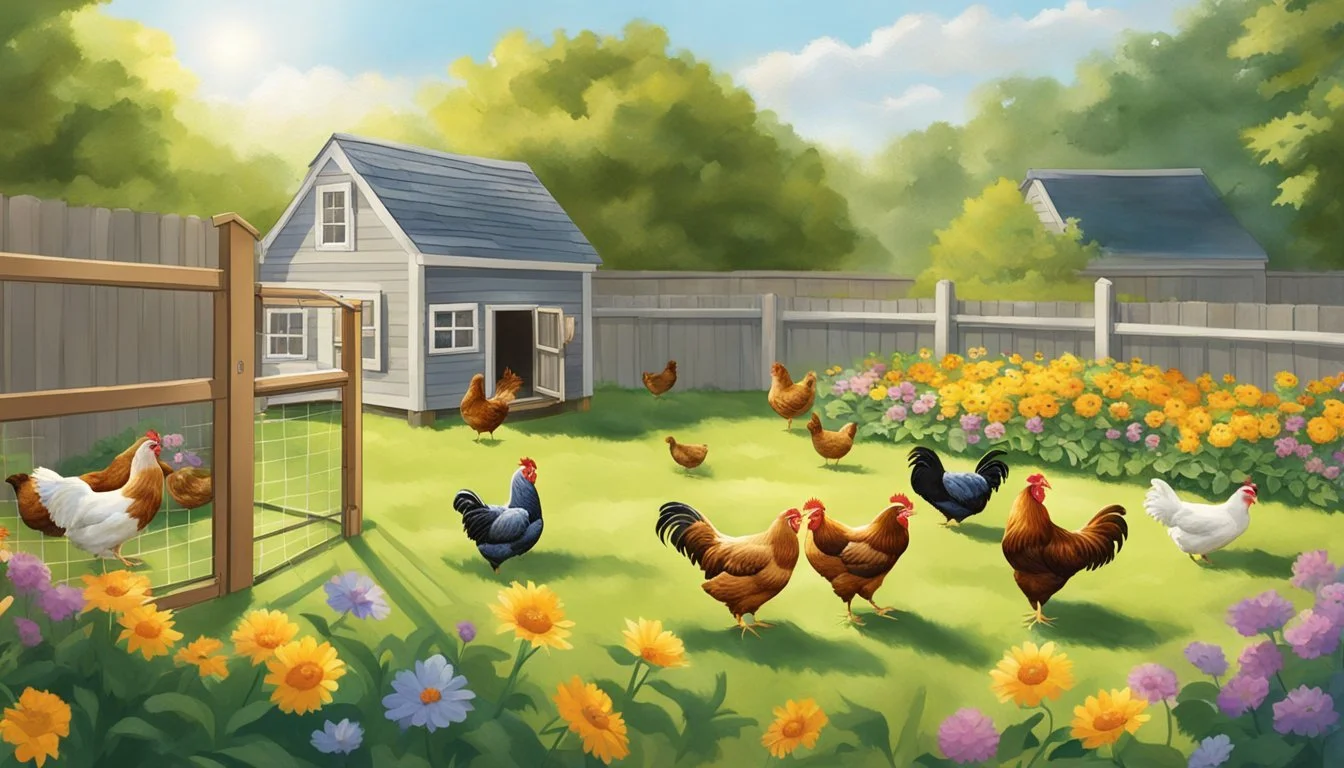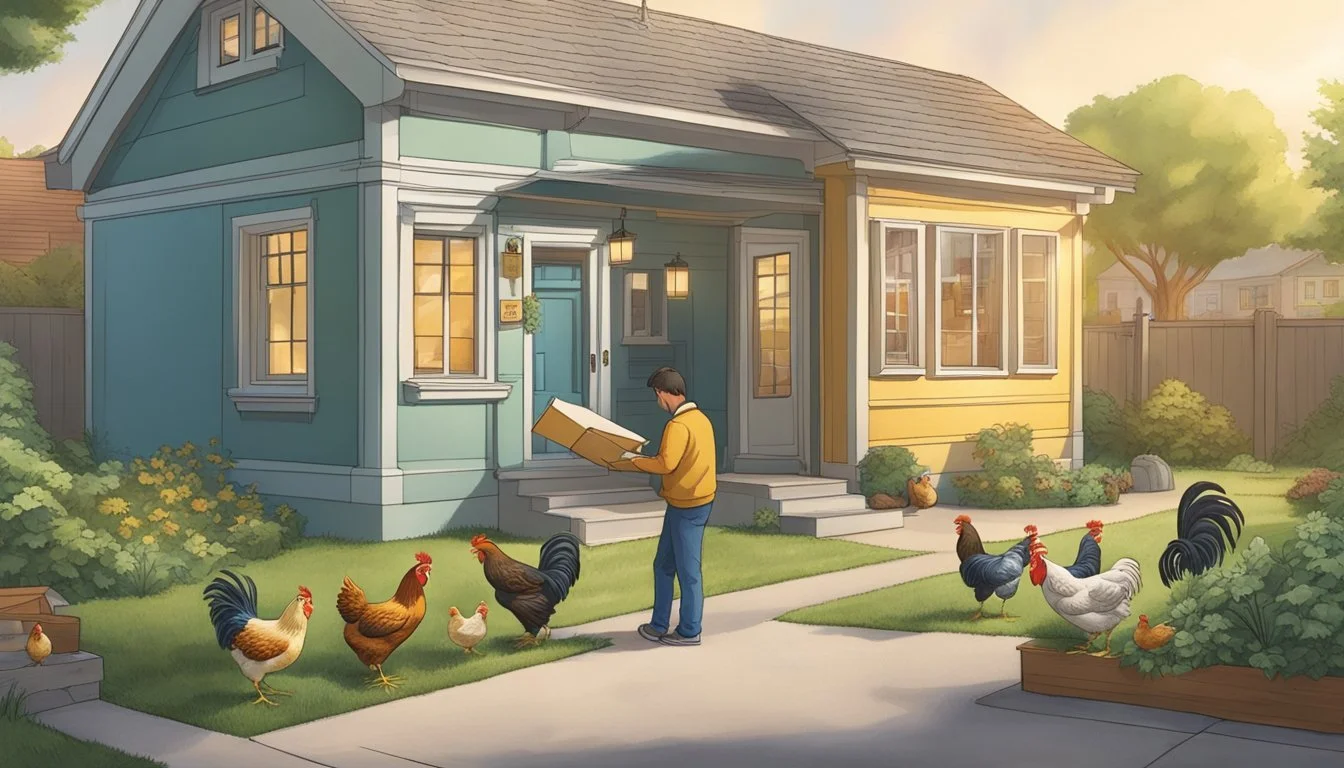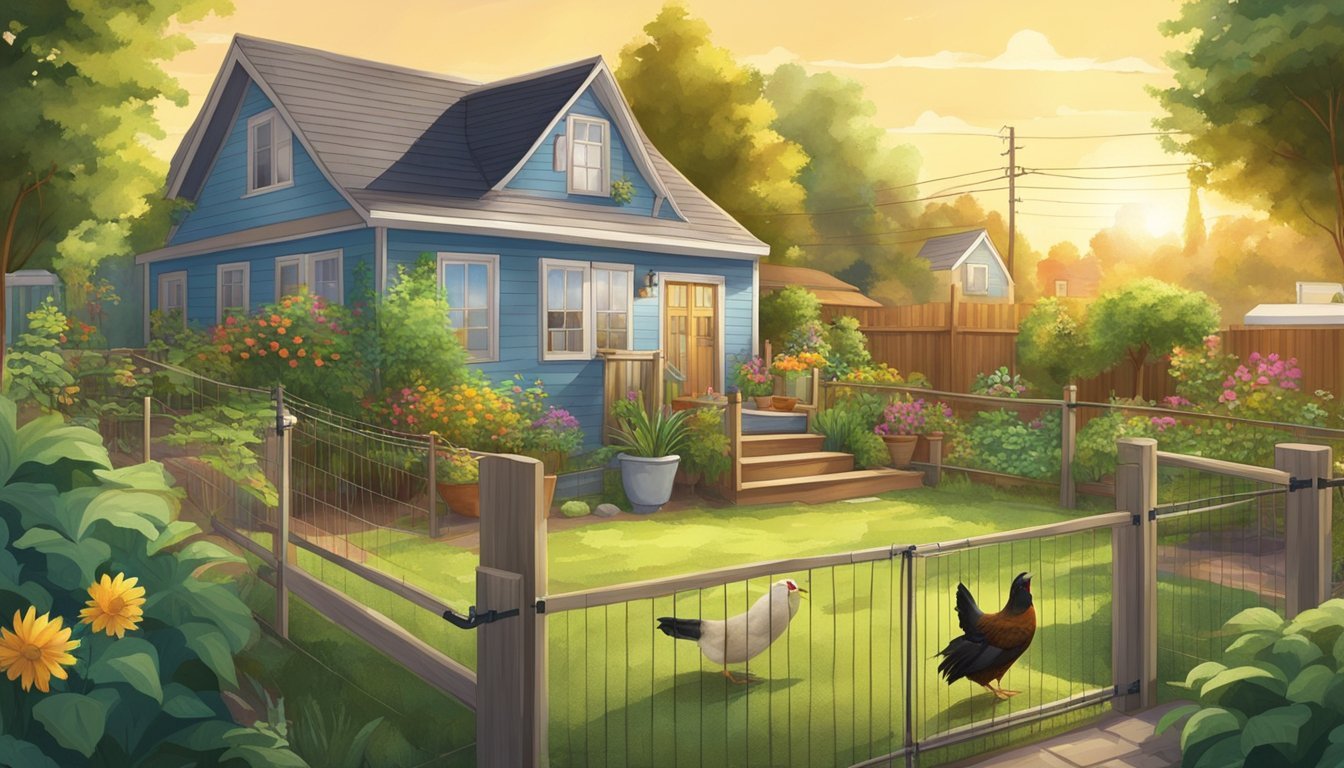Keeping Backyard Chickens in Stamford, CT
Essential Tips for Urban Poultry Farming
In Stamford, Connecticut, the popularity of raising backyard chickens has been on the rise, as it has across many urban and suburban areas. This trend can be attributed to people's desire to produce their own food, engage in sustainable living practices, or simply enjoy the presence of these animals as pets. The City of Stamford accommodates such interests by allowing residents to keep chickens on their property, subject to certain regulations to ensure proper maintenance and community harmony.
Residents aiming to embrace this self-sufficient lifestyle should be aware of the local ordinances pertaining to the keeping of chickens. In Stamford, the number of chickens a resident can keep is not limited by the city ordinance as long as it's within reasonable numbers for the property size. However, roosters are subject to restrictions to mitigate noise issues. Appropriate shelter for chickens is mandated by the city, requiring that coops are kept clean, dry, and secure from predators. Moreover, chicken coops must be placed at least 50 feet away from any neighboring homes to prevent any disturbance and to maintain neighborhood tranquility.
Understanding and adhering to these rules ensures that backyard chicken enthusiasts can enjoy their pursuit without any legal inconveniences. Keeping chickens not only provides an educational experience for families but also offers rewards in the form of fresh eggs and the joy of caring for these animals. As residents consider integrating chickens into their backyards, it is important to approach this venture with preparedness and respect for the community standards set forth by the City of Stamford.
Understanding Stamford Chicken Ordinances
Residents in Stamford, Connecticut considering raising backyard chickens must adhere to specific local ordinances. These regulations are in place to ensure the health and safety of both the chickens and the local community.
Zoning Requirements It is crucial for homeowners to verify with the Stamford Zoning Department as chickens are typically permitted in residential areas. However, the possibility exists for varying stipulations in different neighborhoods or subdivisions.
Permitting Process
Homeowners may need to apply for permits before setting up their chicken coops.
Local Laws and Regulations Stamford’s municipal code provides guidelines on the number of chickens a resident can keep. Although these numbers can fluctuate, it's essential for the homeowner to review the maximum allowed.
Setbacks and Enclosures
There are specific rules concerning the distance of chicken coops from adjoining properties and the necessity for adequate enclosures.
Connecticut Chicken Laws While Connecticut allows backyard chickens broadly, Stamford adheres to its own set of ordinances that may be more or less restrictive.
Key Points to Remember:
Check with the Stamford Zoning Department regarding local zoning regulations for chicken keeping.
Determine if a permit is required and what the process entails.
Understand the maximum number of chickens allowed on your property as per Stamford’s local laws.
Ensure compliance with regulations on coop placement and enclosure specifications.
By following Stamford's chicken ordinances, prospective chicken keepers can maintain their backyard flocks within the bounds of the law.
Securing the Necessary Permits
Before owning backyard chickens in Stamford, CT, it is imperative for residents to understand and comply with the specific regulations set by local government authorities. This includes applying for the required permits, adhering to zoning laws, knowing the limit on the number of chickens allowed, and being aware of restrictions on roosters.
Permit Application Process
Prospective chicken keepers in Stamford must submit a permit application to the local municipality. This involves providing detailed information about the intended location of the chicken coop, the number of chickens, and compliance with health and safety standards. The application will be reviewed by the government authority responsible for issuing permits.
Zoning Requirements
Zoning laws dictate where chickens can be kept. Residential lots in Stamford are subject to specific zoning requirements that must be checked before setting up a coop. The chicken coop must be situated at least 50 feet from any property lines and neighboring dwellings. Applicants should consult the local zoning map or contact the zoning office to verify that their lot falls within an approved area for raising chickens.
Number of Chickens Allowed
In Stamford, there is a maximum number of chickens that can be kept on residential property. While the exact number may vary depending on the size of the lot, prospective owners need to ensure their flock does not exceed this limit. It is advisable to check with the local authorities for the precise maximum number allowed.
Restrictions on Roosters
The city government typically imposes restrictions on roosters due to noise concerns, primarily crowing, which can lead to complaints from neighbors. In many cases, roosters are not permitted in residential zones to prevent disturbances. Chicken owners should verify the regulations regarding roosters to avoid violating local laws.
Chicken Coop and Run Essentials
When constructing a backyard chicken setup in Stamford, CT, it is crucial to focus on designing a sturdy coop, providing enough space for runs, ensuring proper ventilation, and safeguarding your flock from predators. These elements are fundamental for the well-being and productivity of chickens.
Designing a Coop
The design of a chicken coop should cater to the specific needs of the fowl, providing a secure and comfortable shelter. It is imperative to use robust materials that can withstand the elements and deter pests. Features such as nesting boxes for laying eggs and perches for sleeping should be included. The coop should be easy to clean, maintaining a sanitary environment to prevent disease.
Providing Adequate Space for Runs
Chickens require exercise and foraging opportunities to stay healthy. A run attached to the coop needs to offer enough space for chickens to move freely. The rule of thumb recommends:
Per chicken: 8-10 square feet in the run
Total space: Combine coop and run space to provide a minimum of 10 square feet per chicken
A run should be securely fenced to keep chickens penned and safe from potential escape.
Ensuring Ventilation
Good ventilation is critical to remove moisture, ammonia, and other harmful gases from the coop. It also helps regulate temperature and prevent respiratory issues in chickens. Strategic placement of vents or windows can provide ample airflow while still protecting the flock from drafts.
Protection from Predators
Stamford is home to various predators including raccoons, foxes, and hawks. A secure chicken environment is non-negotiable:
Fencing: Use hardware cloth instead of chicken wire for better protection
Roofing: Cover runs with a roof or netting to prevent aerial attacks
Closures: Install locks on doors and nesting boxes that are raccoon-proof
Regular inspection and maintenance of the coop and run are essential to prevent any weak spots where predators might gain access.
Maintaining a Clean and Healthy Environment
Maintaining a clean and sanitary environment is crucial for backyard chickens in Stamford, CT. Owners must focus on regular upkeep and preventive strategies to ensure the health and safety of their poultry.
Regular Cleaning Schedule
One should establish a routine cleaning schedule to maintain clean conditions within chicken coops. Daily, owners need to remove chicken waste, refill water containers with fresh water and check feeders for moldy food. At least weekly, it's important to change the bedding, while a thorough cleaning of the entire coop should be performed monthly to prevent the build-up of harmful pathogens.
Sanitation Best Practices
Adhering to sanitation best practices involves more than cleaning. Owners should:
Disinfect feeders and waterers regularly.
Use predator-proof containers for feed to prevent contamination.
Ensure the shelter is dry and well-ventilated.
Provide dust baths as they are a natural behavior of chickens for staying clean.
Dealing with Odor
To manage odor effectively:
Ventilation is key; a coop should be well-aerated to allow odors to dissipate.
Regular removal of droppings limits odor build-up.
Using absorbent materials such as straw or wood shavings can help neutralize odors.
Disease Prevention
A clean environment directly correlates with disease prevention. Owners should:
Quarantine new or sick birds to prevent the spread of disease.
Keep coops clean to minimize the risk of salmonella, mites, and respiratory illnesses.
Implement a foot dip with a sanitation solution for anyone entering the coop area.
Ensure the animals receive regular veterinary care and vaccinations where appropriate.
By following these guidelines, chicken owners in Stamford, CT can maintain a clean, sanitary, and healthy environment for their backyard flock.
Daily Care and Feeding
Proper daily care and nutrition are essential for the health and productivity of backyard chickens in Stamford, CT. Owners must prioritize balanced feeding and consistent water supply, alongside routine care practices to ensure the well-being of their flock.
Nutritional Requirements
Chickens require a balanced diet containing proteins, carbohydrates, vitamins, and minerals. The exact nutritional needs vary depending on the age and breed of the chicken. Layers, for example, need calcium-rich feed for egg production. It's important to provide formulated poultry feed that meets these requirements. Additional calcium can be supplied with oyster shell supplements as needed.
Chicks (0-8 weeks): Starter feed with 18-24% protein.
Growers (8-20 weeks): Grower feed with 16-18% protein.
Layers (post 20 weeks or laying age): Layer feed with 16-18% protein and increased calcium.
Non-layers/Broilers: Feed with moderate protein and energy content.
Managing Food and Water Supplies
Chickens must have constant access to fresh water. Waterers should be checked and refilled daily to avoid contamination and freezing during colder months. Ensure that the water supply is clean and not prone to tipping over.
For food supplies, chickens typically eat once or twice a day, but the method can vary:
Scheduled Feeding: Offering food at set times each day.
Free-feeding: Providing continuous access to food.
Ensure that feeders are capable of holding enough food for the entire flock and protect them from wild birds and rodents.
Routine Care
Daily observation is crucial to maintain the health of the chickens. Keep an eye out for signs of illness, injury, or distress. A routine care checklist should include:
Coop Cleaning: Regular removal of droppings and wet bedding keeps the coop sanitary.
Inspection: Observe for any abnormal behavior or signs of parasites.
Predator Checks: Verify that housing is secure against potential predators.
Regular handling and socialization can also help in early detection of problems and make the chickens easier to manage. It is the responsibility of the owner to maintain this daily care regimen to ensure their chickens' welfare.
Community and Neighborly Considerations
Keeping backyard chickens in Stamford, CT, requires mindfulness about community relations and adherence to city ordinances. Homeowners should ensure their chicken-keeping practices do not infringe upon their neighbors' comfort or violate local laws.
Reducing Noise and Disruption
Chickens, particularly roosters, can be a source of noise through their crowing. Stamford's Chicken Ordinance stipulates that all poultry must be kept in a way that does not cause disturbance to the neighborhood.
Crowing: Limit the number of roosters or avoid keeping them if possible to minimize early morning noise.
Soundproofing: Invest in soundproofing your chicken coop to reduce the level of noise reaching neighboring residences.
It is crucial to be proactive in addressing any complaints from neighbors regarding noise to maintain a harmonious community.
Fence and Barrier Guidelines
Fencing is an important consideration for chicken owners in Stamford to maintain good relations with the community and comply with zoning requirements.
Property Lines: Ensure chicken enclosures are built at least fifty feet from all property lines and roads.
Ordinances: Adhere to the Stamford Chicken Ordinance which mandates that chicken structures be adequately fenced in and visually screened from the road and neighboring properties.
Properly installed barriers can prevent chickens from straying onto neighboring properties and also minimize any potential issues with community members.
Understanding Local and State Updates
Keeping backyard chickens in Stamford, Connecticut requires awareness of current regulations, which may periodically change. Residents should stay current with local zoning regulations and understand the municipal code as it pertains to chicken laws. State-wide updates can also affect how residents in Stamford as well as other Connecticut cities such as New Haven, Bridgeport, Norwalk, Waterbury, and Hartford participate in this practice.
Staying Informed on Changing Laws
In Stamford, individuals must adhere to local laws that dictate the keeping of backyard chickens. These regulations are subject to change, and it is paramount that residents routinely check for updates. Resources for staying informed include:
Government Websites: The city of Stamford's official website and the Connecticut state portal provide legal documents and zoning ordinances.
Community Meetings: Local council meetings often discuss changes and updates to laws, including those related to chicken keeping.
Educational Institutions: Universities and cooperative extensions in Connecticut provide resources and guidance relating to agricultural practices and laws.
Participating in Local Governance
Engagement in local governance is a strong method for staying abreast of potential changes to chicken laws in Stamford. By participating, residents can:
Voice Concerns: Individuals can attend town hall meetings to express their opinions on proposed changes to local regulations.
Vote on Issues: Registered voters can participate in referendums and elections that could impact local and state laws.
Citizens can collaborate with officials to ensure backyard chicken practices align with community standards and sustainable living goals in the United States.
Dealing with Wildlife and Pets
Keeping backyard chickens in Stamford, CT brings the challenge of safeguarding them from common predators such as foxes, raccoons, and birds of prey. It's also crucial to establish a harmonious relationship between chickens and domestic pets like dogs and cats.
Safe Practices to Deter Predators
Fencing: A solid fence that goes underground can deter digging predators. Chicken wire should be fine enough to prevent the entry of smaller pests.
Secure Coop: Ensure that chickens are locked in a predator-proof coop during the night. The coop should have secure latches that can't be easily manipulated by clever wildlife.
Motion-Activated Lights or Noise: Install lights and noise systems that activate with movement to scare away potential predators.
Wildlife Deterrents: Consider using non-lethal deterrents like predator decoys or odorous substances to make the area less appealing to wildlife.
Regular Checks: Periodically inspect the coop and fencing for any signs of attempted entry or damage.
Integrating Chickens with Other Animals
Introduction Process: Gradually introduce dogs and cats to your chickens, monitoring their interactions closely to ensure safety.
Training: Train dogs especially to recognize chickens as part of the household not to be harmed. Rewards can be used to reinforce non-aggressive behavior.
Separate Spaces: If integration doesn't seem feasible, maintaining separate areas for chickens and other animals is essential. Ensure that any shared spaces are supervised.
In managing the coexistence of backyard poultry and pets in residential areas, the priority is the safety of all animals involved. Implementing effective strategies will afford domestic animals and chickens the opportunity to live in mutual respect and security, while keeping unwanted wildlife at bay.
Legal Responsibilities and Fines
In Stamford, Connecticut, residents maintaining backyard chickens must adhere to municipal codes and zoning regulations to avoid fines and legal issues. Compliance with all local ordinances related to animal welfare, proper care, and sanitary conditions is paramount.
Penalties for Non-Compliance
Violating Stamford's chicken-related ordinances may result in fines. The city's municipal code specifies that:
Keepers of live poultry must maintain a minimum distance of 50 feet from any dwelling or apartment house to avoid fines.
The local authority may impose fines for failing to comply with the specific zoning and sanitary regulations.
The fines are incremental based on the nature and frequency of the violation.
Animal Welfare and Care Regulations
Stamford's laws require that:
Chickens must have access to clean and sanitary enclosures.
Owners have the responsibility to prevent any illness or disease spread.
Regular maintenance and cleaning of the chicken's living environment is mandated.
The regulations are crafted to ensure a humane environment for the chickens, as well as a safe and clean area for the residents.
Adherence to these regulations will ensure that keeping chickens is both a rewarding experience and a positive contribution to the community's sustainable practices.
Alternative Poultry and Livestock Options
For residents of Stamford, Connecticut considering backyard farming beyond chickens, there are other poultry and livestock options that can be kept within certain regulations. It's important to note that livestock choices should be compatible with the lot size and zoning district of one's property.
Considering Ducks and Geese
Ducks and geese can be a viable option for those looking for alternative poultry to raise. These birds require access to water for bathing and foraging and are generally known for being hardier in various climates. They do, however, produce more noise and require larger spaces to roam compared to chickens. The specific requirements for keeping ducks and geese in Stamford may vary depending on the zoning district, so it is advisable for residents to consult local ordinances before adding these birds to their property.
Larger Livestock in Stamford
When contemplating the addition of larger livestock, such as goats or cattle of the bovine species, residents must ensure they have sufficient lot size to meet the animals' needs. These animals require appropriate shelter, fencing, and space to maintain their health and well-being. In Stamford, any structure housing such livestock must be at least fifty feet from any dwelling or apartment house. Moreover, stables or pens must be kept clean to meet maintenance regulations. These requirements help ensure that all farm animals are accommodated responsibly, considering both the well-being of the animals and the surrounding community.











